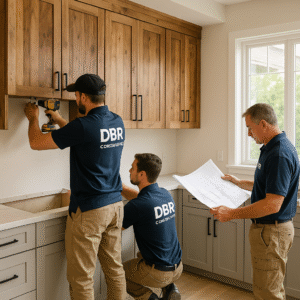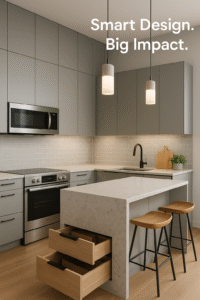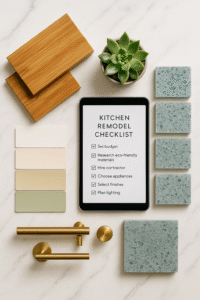The Ultimate Guide to Eco-Friendly Kitchen Renovations
An eco-friendly kitchen renovation is more than just a trend—it’s a smart, forward-thinking investment that improves your home’s value, lowers monthly energy costs, and reduces your overall environmental footprint. Whether you’re planning a small kitchen remodel to freshen up a compact space or a complete kitchen renovation that transforms every surface, going green can make a meaningful impact on your daily life, your family’s health, and even your neighborhood.
At DBR Construction, we specialize in kitchen remodeling near you, delivering creative, sustainable solutions that balance style, budget, and functionality. This guide will walk you through everything you need to know, from kitchen remodel ideas and cost planning to common problems, smart DIY considerations, and proven ways to maximize your kitchen remodel ROI.
Why Choose an Eco-Friendly Kitchen Remodel?
More homeowners today are prioritizing sustainability and efficiency in their home remodeling projects. Eco-friendly kitchen remodels not only help conserve precious natural resources but also create safer, healthier spaces for your family to cook, gather, and make memories.

Benefits of an Eco-Friendly Kitchen Renovation
When you invest in an eco-friendly remodel, you unlock a host of benefits that continue to pay off year after year:
- Energy savings: Modern appliances, energy-efficient lighting, and smart thermostats work together to cut your monthly utility bills significantly, saving hundreds of dollars annually.
- Improved indoor air quality: Low-VOC paints, finishes, and natural materials help reduce toxins and allergens, protecting your respiratory health.
- Increased resale value: More buyers today are drawn to homes with sustainable home improvement features, making your property more attractive when it’s time to sell.
- Positive environmental impact: By choosing recycled, reclaimed, or sustainably sourced materials, you create less waste and contribute to lower carbon emissions.
- Enhanced comfort and style: Eco-friendly doesn’t have to mean sacrificing beauty—today’s green materials are available in countless colors, textures, and finishes.
Whether you’re upgrading worn-out kitchen cabinets, replacing outdated kitchen countertops, installing new kitchen flooring, or rethinking your kitchen layout design, an eco-friendly approach offers meaningful long-term rewards and peace of mind.
Planning Your Eco-Friendly Kitchen Remodel
Thorough planning is essential for any successful remodel. When you’re prioritizing sustainability, it’s especially important to budget carefully, plan ahead for sourcing eco-friendly materials, and schedule enough time for proper installation.
Define Your Kitchen Renovation Budget
A clear, detailed kitchen renovation budget forms the backbone of a smooth project. Take time to estimate and account for the following costs:
- Cabinets and storage solutions
- Countertops
- Flooring materials and installation
- Lighting fixtures and electrical work
- Appliances (preferably ENERGY STAR certified)
- Labor and professional installation
- Permit fees and inspections
- A contingency fund (generally 10–15% of your total budget)
On average, kitchen remodel cost can range anywhere from $15,000 for a modest update in a small kitchen to $50,000 or more for a high-end, full-scale renovation with custom finishes and premium materials. If you’re focusing on sustainability, some materials—like reclaimed wood or recycled glass—may cost slightly more upfront, but they deliver savings and environmental benefits over time.
Create a Kitchen Remodel Checklist
A well-organized checklist helps you stay on schedule and avoid costly mistakes that can derail your project timeline. Use this simple guide to plan every phase of your remodel:
- Assess your current kitchen layout design and note what works—and what doesn’t.
- Research eco-friendly materials, appliances, and fixtures that align with your vision.
- Set a realistic timeline based on material lead times and contractor availability.
- Request estimates and references from multiple trusted kitchen remodeling contractors.
- Review and apply for any necessary permits and ensure you understand local building codes.
- Plan for waste disposal and recycling to minimize landfill impact.
Tip: Download DBR Construction’s Kitchen Remodel Checklist to stay organized and ensure nothing gets overlooked as you move through each step.
Eco-Friendly Kitchen Remodel Ideas
From sustainably harvested materials to energy-efficient appliances, countless products today can help you create a green kitchen that feels warm, functional, and timeless.
Here are some of the most effective ideas to inspire your renovation and make the most of your investment:

Sustainable Kitchen Cabinets
Cabinets often represent the single largest visual element in your kitchen—and the biggest portion of your budget. When you choose responsibly sourced cabinetry, you’re making a powerful commitment to sustainability.
Options to Consider:
- Reclaimed wood: Salvaged wood from barns, factories, or old homes brings unique character while reducing demand for new lumber.
- Bamboo: Fast-growing and renewable, bamboo offers a sleek, modern look.
- FSC-certified hardwood: Certified by the Forest Stewardship Council to ensure responsible forest management practices.
Common Issue: Many homeowners focus on the cabinet doors and frames but overlook the adhesives and finishes used during manufacturing. Be sure to confirm that any glues, paints, or sealants are low-VOC (volatile organic compounds) to protect your indoor air quality and your family’s health.
Energy-Efficient Kitchen Countertops
When planning your kitchen renovation, selecting the right countertops is one of the most important decisions you’ll make. Sustainable surfaces offer the durability and performance you need without sacrificing style or harming the environment.
Consider options such as:
- Recycled glass countertops: These eye-catching counters combine crushed recycled glass pieces in a cement or resin binder. They’re available in countless colors and patterns, from subtle neutrals to bold jewel tones. Recycled glass surfaces are heat-resistant, non-porous, and easy to maintain.
- Paper composite countertops: Made by compressing recycled paper with resin, these counters are surprisingly strong, lightweight, and warm to the touch. They resist stains and scratches and have a matte finish that suits modern and transitional kitchens.
- Sustainably sourced stone: If you love the look of natural stone, consider suppliers that quarry slabs responsibly and use low-impact extraction methods. Look for certifications that confirm the stone was harvested in an environmentally sensitive way.
Pro Tip: Always ask your supplier about the manufacturing process and maintenance needs to ensure your new countertops will stand the test of time.
Eco-Friendly Kitchen Flooring
Kitchen flooring has a major impact on both the appearance of your space and your environmental footprint. Luckily, there are many eco-conscious options that are attractive, durable, and safe for your family:
- Bamboo: Renewable, fast-growing, and available in a wide range of finishes. Bamboo is harder than many hardwoods, making it perfect for high-traffic kitchens.
- Cork: Harvested from the bark of cork oak trees without harming the tree itself. Cork floors are soft underfoot, naturally antimicrobial, and provide excellent sound insulation.
- Reclaimed hardwood: Salvaged wood repurposed from old barns, factories, or homes. Reclaimed planks have unique character, with knots and patina that tell a story.
- Recycled tiles: Glass or ceramic tiles made from post-consumer materials can be used for flooring or backsplashes, offering color and texture while reducing landfill waste.
Pro Tip: Look for products certified by GREENGUARD or FloorScore to ensure low emissions and healthier indoor air.
Smart Kitchen Lighting
Modern lighting solutions can make your kitchen more functional while significantly reducing your energy consumption.
Options to consider:
- LED bulbs: Use up to 75% less energy than traditional incandescent bulbs and last much longer.
- Smart lighting systems: Let you control brightness, color temperature, and schedules via smartphone or voice command, ensuring you only use energy when you need it.
- Task lighting: Focused illumination over work areas such as counters and sinks improves safety and productivity.
- Dimmers and sensors: Allow you to adjust light levels to save energy and create ambiance.
Tip: Install under-cabinet LEDs to brighten prep areas without harsh glare.
Kitchen Remodel Trends to Watch
Sustainability goes hand-in-hand with innovation. Here are the most exciting trends transforming modern kitchens:
- Touchless faucets: Reduce the spread of germs and conserve water by shutting off automatically.
- Smart appliances: Refrigerators, ovens, and dishwashers that sync with your devices and optimize energy use.
- Hidden storage solutions: Pull-out cabinets, toe-kick drawers, and concealed spice racks make small kitchens more efficient.
- Water purification systems: Improve your family’s health by filtering contaminants and reducing plastic bottle waste.
- Integrated charging stations: Keep your devices powered without cluttering your counters.
Common Problems in Kitchen Remodels
Even with the best planning, unexpected issues can arise. Be prepared for these common problems:
- Hidden damage behind walls: Old plumbing leaks, rot, or mold can add significant cost and delay. Always budget extra for surprises.
- Material delays: Sustainable materials sometimes require special orders or longer lead times. Order early to avoid frustration.
- Permit and code complications: Each municipality has specific regulations, and failing inspections can halt your project.
- Scope creep: Adding extra features or upgrades mid-project can quickly push you over budget.
Working with experienced kitchen remodeling contractors like DBR Construction helps you anticipate and manage these challenges proactively.
DIY Kitchen Remodel: Should You Do It Yourself?
A DIY kitchen remodel can be appealing, especially for handy homeowners eager to save on labor costs. However, it’s important to understand the risks and limitations:
Pros of DIY
- Lower labor expenses: You can invest more in quality materials.
- Flexible scheduling: Work at your own pace without coordinating with contractors.
- Personal satisfaction: Enjoy the accomplishment of building something yourself.
Cons of DIY
- Hidden costs: Mistakes can be expensive to fix.
- Permitting challenges: Many electrical, plumbing, and structural changes require professional permits and inspections.
- Time commitment: Remodeling a kitchen can take months if you only work on weekends.
- No warranty: Professional contractors guarantee their work—DIY projects do not.
Tip: If you want to be hands-on, tackle smaller projects like painting walls or installing a backsplash, but leave complex systems to licensed professionals.
Financing Your Kitchen Remodel
Sustainable upgrades can add upfront costs, but you’ll benefit from long-term savings and increased property value. To fund your renovation, consider:
- Home equity loans or lines of credit: These options often offer lower interest rates because they’re secured by your property.
- Personal loans: Useful for smaller projects or if you lack home equity.
- Green energy incentives and tax credits: You may qualify for rebates on ENERGY STAR appliances or renewable energy systems.
- Manufacturer rebates: Appliance brands frequently offer cashback deals or extended warranties.
DBR Construction can help you explore kitchen remodel financing plans that fit your goals and budget.
Kitchen Remodel Timeline
How long will your kitchen remodel take? Every project is unique, but here’s a general guide:
- Planning and design: 2–4 weeks to finalize the layout, materials, and permits.
- Ordering materials: 3–6 weeks if you’re choosing specialty or eco-friendly products.
- Demolition: 1 week to remove old cabinets, flooring, and fixtures.
- Installation and finishing: 6–8 weeks to complete all phases of construction.
Tip: Always add extra time for contingencies—especially if you’re coordinating other renovations or live in an older home.
Maximizing Your Kitchen Remodel ROI
According to remodeling industry studies, a thoughtfully planned kitchen renovation can recoup 60–80% of your investment when it’s time to sell your home. To maximize your ROI:
- Choose timeless styles: Neutral colors and classic finishes age better than fleeting trends.
- Invest in ENERGY STAR appliances: Reduce utility bills and attract eco-conscious buyers.
- Select durable materials: Reclaimed wood, recycled stone, and sturdy fixtures stand up to daily use.
- Improve lighting and storage: A bright, organized kitchen is a major selling point.
Small Kitchen Remodel: Big Impact in Tiny Spaces
Don’t underestimate the power of a small kitchen remodel. Even a compact layout can feel open and functional with the right approach:
- Open shelving: Replaces bulky upper cabinets to create visual space.
- Light-colored cabinets: Reflect more light and make the room feel larger.
- Multi-functional islands: Incorporate storage, prep space, and seating in one footprint.
- Pull-out pantry systems: Maximize every inch of cabinet depth.
Tip: Smart kitchen layout design can improve workflow and help you enjoy your kitchen every day.
Bathroom Remodels: Sustainable Upgrades for Your Home
Many homeowners choose to tackle a bathroom remodel alongside the kitchen to save time and take advantage of economies of scale. Here’s what to consider when going green in the bath:
Eco-Friendly Bathroom Remodel Ideas
- Low-flow showerheads and faucets: Save thousands of gallons of water each year.
- Dual-flush toilets: Use only the water you need with every flush.
- Recycled tiles: Made from glass, ceramic, or porcelain for unique style.
- LED lighting: Energy-efficient and long-lasting illumination.
- Non-toxic paints and finishes: Protect indoor air quality and your family’s health.

Common Bathroom Remodel Problems
Like kitchens, bathrooms can conceal hidden problems:
- Poor ventilation: Trapped humidity leads to mold growth and material damage.
- Outdated plumbing: Old pipes may need replacing to meet code.
- Inadequate waterproofing: Improperly sealed showers can cause costly leaks.
- Limited storage: Small bathrooms often require creative solutions.
Tip: Working with professional bathroom remodeling contractors like DBR Construction ensures every detail is handled with care.
Bathroom Remodel Checklist
- Define your bathroom renovation budget early.
- Choose sustainable materials and fixtures.
- Upgrade lighting and ventilation to prevent moisture damage.
- Plan for smart storage solutions.
- Select water-saving faucets and toilets.
- Establish your bathroom remodel timeline and contingency plan.
Bathroom Remodel Cost and Financing
The average bathroom remodel cost typically ranges from $8,000 to $25,000, depending on factors like the size of the bathroom, the quality of materials you select, and whether you’re making structural changes.
Small bathroom remodels focused on cosmetic updates—such as new lighting, fresh paint, and updated fixtures—can be completed at the lower end of the price range. However, full-scale renovations involving plumbing relocation, custom tile work, or luxury upgrades like heated floors can easily push costs higher.
When planning your bathroom renovation budget, don’t forget to account for:
- Demolition and debris disposal
- Permits and inspections
- Plumbing and electrical updates
- Custom cabinetry or built-ins
- Glass shower enclosures or bathtub remodel
- Specialty lighting
Many sustainable upgrades, such as low-flow toilets or ENERGY STAR ventilation fans, qualify for tax credits, rebates, or special financing programs, helping offset the initial investment.
DBR Construction offers flexible bathroom remodel financing options to make your project more accessible and manageable. From home improvement loans to payment plans tailored to your budget, we’ll help you find the best solution to achieve your dream bathroom without compromising quality.
DIY Bathroom Remodel: Proceed with Caution
DIY bathroom remodels can be rewarding, but they often present challenges that catch homeowners off guard. While it may seem simple to replace a vanity or re-grout tiles, bathrooms involve specialized systems—especially plumbing and waterproofing—that demand skill and experience.
Tasks you may tackle yourself:
- Painting walls with moisture-resistant paint
- Replacing cabinet hardware
- Updating towel bars or mirrors
- Installing peel-and-stick backsplashes
Tasks best left to professionals:
- Moving plumbing lines or drains
- Waterproofing shower enclosures
- Installing complex tile patterns
- Upgrading electrical wiring to meet modern codes
Risks of DIY bathroom remodeling include:
- Leaks that lead to mold or structural damage
- Costly mistakes requiring rework
- Extended timelines due to learning curves
- Voiding warranties on materials or fixtures
If you choose to DIY, start small, follow manufacturer instructions closely, and always consult licensed professionals when dealing with plumbing, electricity, or structural work.
Home Remodeling ROI: Make Every Dollar Count
Beyond kitchens and bathrooms, comprehensive home remodeling can dramatically increase your property’s value, comfort, and efficiency. Thoughtful upgrades often result in higher resale prices and shorter time on the market when you decide to sell.
Popular renovations to increase home value include:
- Upgrading insulation: Improves energy efficiency and reduces heating/cooling costs.
- Installing energy-efficient windows: Keeps your home comfortable year-round and qualifies for rebates.
- Modernizing flooring: Replacing dated carpet or worn vinyl with engineered hardwood or luxury tile.
- Repainting with low-VOC paints: Instantly refreshes interiors while improving indoor air quality.
Home remodeling ROI varies by project scope and market trends, but industry research shows that major upgrades often recoup 70–80% of their costs. When you combine energy-efficient improvements with timeless design, you create lasting value that appeals to today’s buyers.
Remodeling Permits and Regulations
Navigating permits is a crucial part of any kitchen remodel, bathroom renovation, or larger home improvement project. Permits ensure your work complies with local building codes and safety regulations. Skipping this step can result in:
- Expensive fines
- Delays due to failed inspections
- Problems when selling your home later
- Potential insurance issues if something goes wrong
DBR Construction guides you through every stage of the permitting process, including:
- Electrical and plumbing codes: Ensuring wiring, outlets, and fixtures meet safety standards.
- Structural changes: Reinforcing walls or removing load-bearing partitions safely.
- Energy efficiency requirements: Meeting codes for insulation, ventilation, and appliance ratings.
- Local zoning laws: Verifying your plans comply with setback rules and property lines.
We handle permit applications, schedule inspections, and coordinate with local authorities so you don’t have to.
Remodeling Timeline and Tips
Every project has its own timeline, depending on the size of the space, the complexity of the work, and material availability. Generally, home remodeling timelines range from a few weeks for simple updates to several months for major renovations.
Tips to stay on schedule:
- Finalize designs and selections before work begins: Changing your mind mid-project is the #1 cause of delays.
- Order materials early: Sustainable products and custom items often have longer lead times.
- Work with licensed contractors: Professionals keep projects moving efficiently and handle unexpected issues.
- Communicate regularly with your remodeling team: Weekly check-ins help prevent misunderstandings.
Pro Tip: Always build 10–15% extra time into your schedule to account for surprises—especially if you live in an older home with hidden issues.

Home Remodeling Mistakes to Avoid
Avoid these common pitfalls to save time, money, and stress during your remodel:
- Underestimating your budget: Be realistic about costs and set aside a contingency fund for unexpected expenses.
- Choosing trends over timeless design: Fads fade quickly, while classic styles hold their appeal.
- Hiring unlicensed contractors: It may save money upfront but can lead to poor workmanship and liability risks.
- Ignoring permits: Unpermitted work can halt progress and create problems when selling your home.
- Over-customizing: Highly personalized designs may not appeal to future buyers.
DBR Construction will help you make smart decisions that balance your vision with long-term value.
Maintenance Tips for Sustainable Upgrades
Once your renovation is complete, proper maintenance will keep your investment looking beautiful and performing efficiently for years to come:
- Use natural cleaning products: Harsh chemicals can damage finishes and harm indoor air quality.
- Check seals and caulking: Inspect and replace caulk around sinks, tubs, and backsplashes annually to prevent water damage.
- Change HVAC filters regularly: Clean air filters help maintain healthy indoor air and keep systems running efficiently.
- Update smart appliances and lighting: Keep firmware current for security and optimal performance.
- Wipe down surfaces regularly: Clean countertops and cabinets with mild soap and soft cloths to preserve finishes.
Following these tips ensures your eco-friendly kitchen and bathroom continue to deliver comfort, health, and efficiency long after construction ends.
Frequently Asked Questions
What is the most cost-effective way to start an eco-friendly kitchen remodel?
Start with small changes like switching to LED lighting, installing water-saving faucets, and using low-VOC paints. These improvements are affordable and have immediate benefits.
How long does a typical kitchen remodel take from start to finish?
Most kitchen remodels take 8–12 weeks depending on size, materials, and permitting. A small kitchen remodel could be completed in as little as 4–6 weeks if you plan carefully.
What are the biggest challenges in an eco-friendly remodel?
The most common challenges include:
- Longer lead times for sustainable materials.
- Higher upfront costs.
- Finding contractors experienced in green building practices.
DBR Construction specializes in overcoming these challenges with streamlined sourcing and project management.
Is an eco-friendly remodel worth the investment?
Yes. Not only do you improve indoor air quality and energy efficiency, but you can also see a kitchen remodel ROI of 60–80%, especially when you focus on timeless upgrades that appeal to buyers.
Can I finance my remodel project?
Absolutely. Many homeowners use:
- Home equity loans
- Personal loans
- Energy-efficiency rebates
DBR Construction can help you explore the best kitchen remodel financing and bathroom remodel financing options.
How do I find reliable kitchen remodeling contractors near me?
Ask for:
- References and reviews
- Proof of licensing and insurance
- Detailed project estimates
- Experience with eco-friendly projects
DBR Construction is fully licensed, insured, and trusted in the community.
Should I remodel my kitchen and bathroom at the same time?
Remodeling both spaces together can save time and money by:
- Reducing labor costs
- Consolidating permits
- Simplifying scheduling
However, it may require more upfront budgeting.
How can I maximize storage in a small kitchen remodel?
Consider:
- Floor-to-ceiling cabinets
- Pull-out pantry systems
- Corner drawers
- Multi-functional islands
Our design team can create custom solutions to fit any layout.
Ready to Create the Sustainable Kitchen or Bathroom of Your Dreams?
At DBR Construction, we turn inspiration into reality. Whether you need a small kitchen remodel, a luxury bathroom renovation, or a full eco-friendly home makeover, our expert team is here to guide you every step of the way.
✅ Licensed and insured professionals
✅ Decades of remodeling experience
✅ Award-winning design and craftsmanship
✅ Transparent estimates and financing options
✅ Projects completed on time and on budget
📞 Contact us today to schedule your free consultation and discover how an eco-friendly remodel can transform your home and your life.

